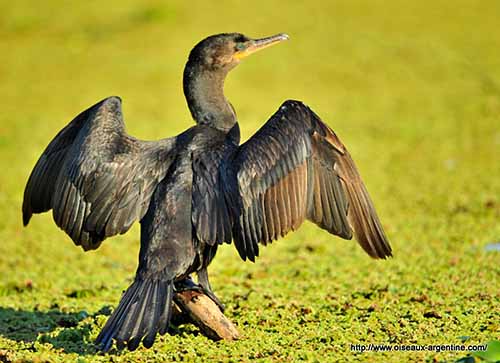
Text by Nicole Bouglouan
Photographers :
Roger Ahlman
Pbase Galleries Peru and Ecuador
John Anderson
John Anderson Photo Galleries
Didier Buysse
Vision d’Oiseaux
Steve Garvie
RAINBIRDER Photo galleries
Tom Grey
Tom Grey's Bird Pictures
Patrick Ingremeau
TAMANDUA
Eduardo Andrés Jordan
MIS AVES – AVES DE ARGENTINA
Ian McHenry
My New Zealand Birds
Tom Merigan
Tom Merigan’s Photo Galleries
Otto Plantema
Trips around the world
Simon Tan
PBase Bird galleries
Ingo Waschkies
My bird pictures on Pbase
Philippe et Aline Wolfer
OISEAUX D’ARGENTINE
Nicole Bouglouan
PHOTOGRAPHIC RAMBLE
Sources:
HANDBOOK OF THE BIRDS OF THE WORLD vol 1 by Josep del Hoyo-Andrew Elliot-Jordi Sargatal - Lynx Edicions - ISBN: 8487334105
THE HANDBOOK OF BIRD IDENTIFICATION FOR EUROPE AND THE WESTERN PALEARCTIC by Mark Beaman, Steve Madge - C. Helm - ISBN: 0713639601
L’ENCYCLOPEDIE MONDIALE DES OISEAUX - Dr Christopher M. Perrins - BORDAS - ISBN: 2040185607
A Complete Guide to Antarctic Wildlife by Hadoram Shirihai and Illustrated by Brett Jarrett - Edited by Guy M. Kirwan - ALUL.A Press Oy, Finland - ISBN 9519894705
BirdLife International (BirdLife International)
Wikipedia, the free encyclopaedia
Animal Diversity Web (University of Michigan Museum of Zoology)
CREAGUS@Monterey Bay (Don Roberson)
What does the cormorant (bird) symbolize in mythology?
Ukai – The Fascinating Ancient Art of Fishing with Cormorants
FAMILY PHALACROCORACIDAE
Order Suliformes
Cormorants and Shags
The family Phalacrocoracidae includes between 26 and 41 species according to a wide variety of differing opinions. Previously, only one genus, Phalacrocorax, was representative of this family. Now, three genera are recognized, Leucocarbo, Microcarbo and Phalacrocorax.
Cormorants and shags are very gregarious and form huge breeding colonies on coastal cliffs and islets. They roost in large flocks and perform sometimes collective fishing at abundant food sources. They can be seen on exposed perches with spread wings and tail, drying their plumage after some pursuit-diving. This is a cormorant’s typical posture, although the shags living in Antarctic and subantarctic regions do not perform “wing-spreading” probably as an adaptation to the very cold climate and to avoid the heat loss.

P. brasilianus
The species included in the genus Leucocarbo, the blue-eyed shags, have blue, purple or red eyering (but not a blue iris). They often have dark, glossy upperparts and white underparts with black outer thighs, variable white upperwing patch, pink feet, bright coloured knobs at base of the upper mandible and recurved crest on the forecrown.
These species occur in the colder part of the Southern Hemisphere, and some of them are endemic to remote subantarctic islands. According to the authors, there are between 8 and 14 shag species in the genus Leucocarbo.
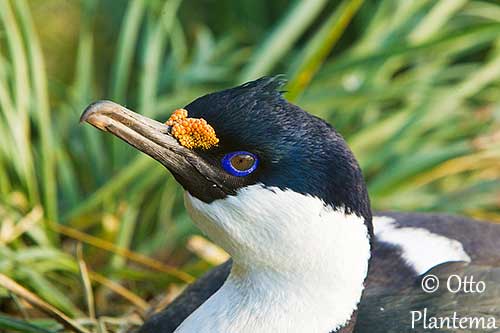
L. georgianus
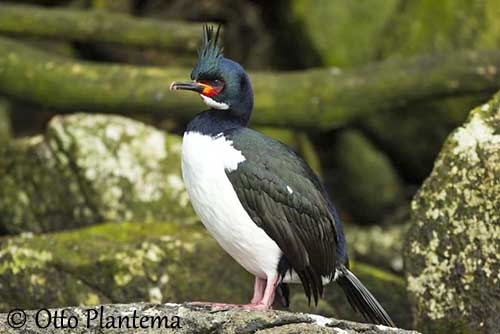
L. campbelli
The genus Microcarbo is that of the small, relatively long-tailed cormorants and includes five living species. They have mostly dark plumage overall, except the Little Pied Cormorant (Microcarbo melanoleucos) which has white underparts and largely white head.
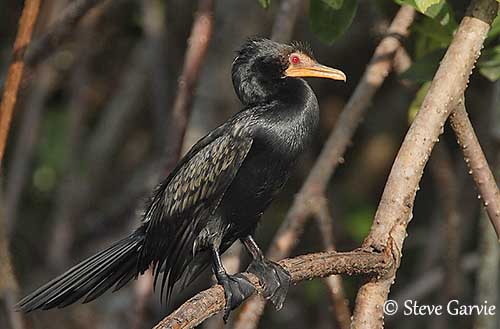
Reed Cormorant or Long-tailed Cormorant
M. africanus
The genus Phalacrocorax includes the typical cormorants with dark glossy plumage overall and white outer thighs, although a few species have white underparts and head sides. The breeding birds have bright coloured face, short crest or white filoplumes, and usually green eyes, except the Bank Cormorant (Phalacrocorax neglectus) which has yellowish iris. They are larger than other species.
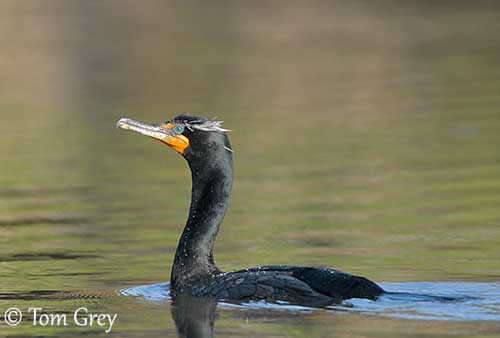
P. auritus
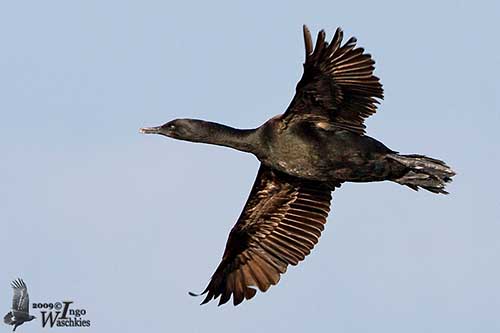
P. neglectus
The Flightless Cormorant (Phalacrocorax harrisi) from Galapagos Islands is the only species unable to fly. It has dark plumage overall and turquoise iris.
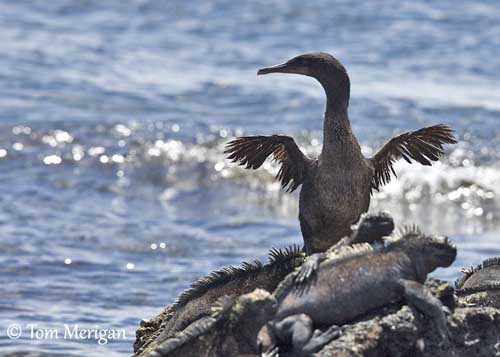
P. harrisi
Cormorants and shags feed primarily on fish, often slow-moving preys. However, other aquatic animals can be consumed too, including invertebrates such as crustaceans, cephalopods and molluscs of various species. When they feed on inland waters, they take amphibians (frogs and tadpoles), aquatic insects and water snakes and turtles if available. Small birds and mammals have been occasionally recorded.
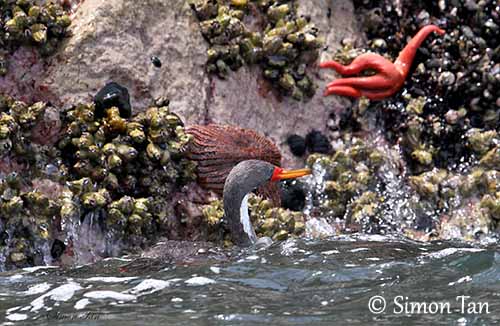
P. gaimardi
The fish are usually small, in average between 12 and 24 centimetres in length. But larger preys can be taken, including long eels of up to 60 centimetres and other bulky preys. Some cases of cormorants choked to death by consuming too large preys are sometimes reported. The indigestible parts (bones and scales) are regurgitated once a day in the form of pellets, usually at dawn, just before to reach the feeding grounds.
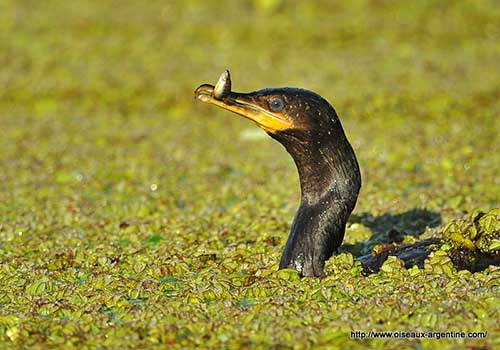
P. brasilianus
Their diet varies seasonally and depends on the food availability in an area. Most bottom-dweller preys are taken in fairly shallow marine or inland water. However, some species such as the Double-crested Cormorant and the Great Cormorant from the Canadian Atlantic coast feed in mid-water on shoals of capelin and Atlantic herring which spawn near the coast.
Some species can be totally dependent on pelagic shoaling fish. The Guanay Cormorant (Leucocarbo bougainvillii) is closely related to the anchoveta Engraulis ringens, whereas the Cape Cormorant (P. capensis) is fond of both the South African pilchard and the Cape anchovy. All these species of fish are extremely abundant, but natural cycles or overfishing by humans can lead to the scarcity of this food and affect the cormorant’s populations.
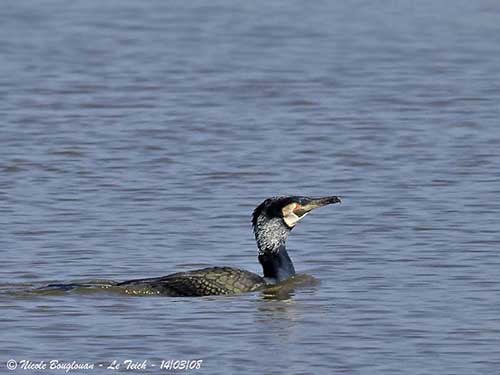
P. carbo
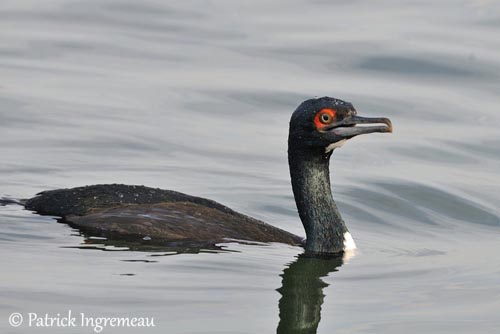
L. bougainvillii
Their foraging bouts are fairly short, between 30 and 60 minutes, related to the fact that they cannot roost on the water and they have to dry their plumage before to dive again.
Cormorants and shags perform pursuit-diving. Some species can reach depths of at least 25 metres, but the Macquarie Shag, the Brandt’s Cormorant and the Pelagic Cormorant may reach depths of 50 metres. They slip gently under the water with a little leap forwards and pursue the prey underwater by propelling themselves with the webbed feet. The fish is caught with the bill. Then, they return to the surface and throw it into the air in order to turn the fish in suitable position before to swallow it head first.
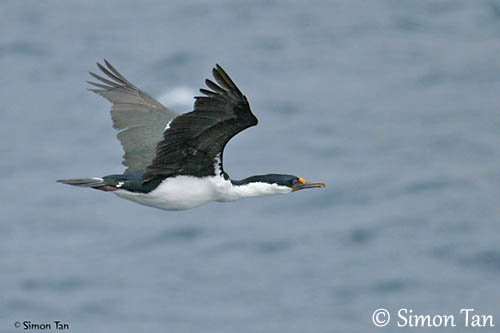
L. purpurascens
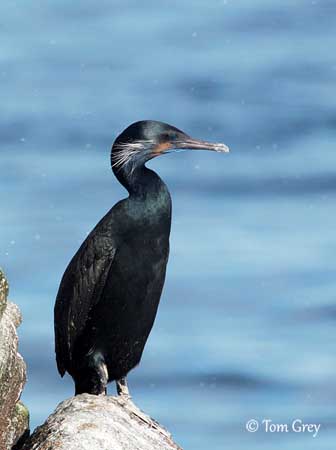
P. penicillatus
If there are abundant food sources, they can fish in flocks and perform co-operative fishing accompanied by some vocalizations. The birds are close to each other in a fan-shape, and advance together, swimming and diving in unison.
This behaviour is similar to that of pelicans, but don’t forget that cormorants and shags were formerly included in the order Pelecaniformes.
These birds are very gregarious and are living in large flocks both at roosts and breeding colonies. They have developed visual displays to communicate. These displays are used to announce their movements such as departure or arrival on the wing, or moving about on foot, so that the birds do not alarm the mate, the chicks or the neighbours.
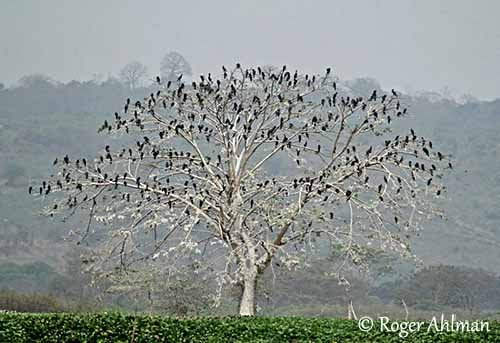
P. brasilianus
The roosts are situated in safe positions on islands, rocks and sea cliffs. Several species also roost in trees, bushes or reeds, surrounded by water. Like the breeding colonies, the nightime roosts can be far from the feeding areas, and the cormorants spend hours each day flying in large flocks in V-formation or in long undulating lines. Over water, they fly low over the surface, but over land or during longer flights, they travel at great heights. The marine species usually follow the coastline and avoid flying over land.
The flight is powerful with regular, continuous wingbeats sometimes interspersed with occasional glides. Some species can reach speeds of up to 80 km/h with help of wind or thermals.
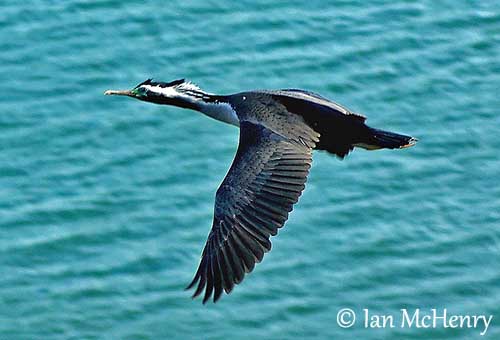
P. punctatus
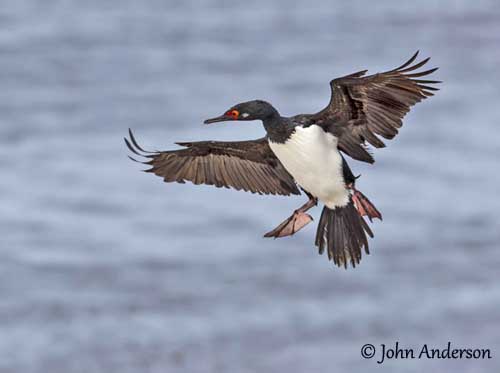
P. magellanicus
They land on the water by fanning the tail and stretching the webbed feet before touching the surface. They run along the water surface for the take-off while flapping actively the wings. When possible, they use the wind to help both landing and take-off and usually prefer open waters.
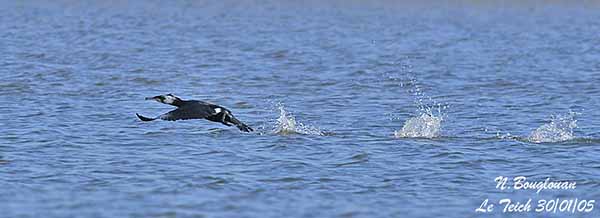
P. carbo
The Flightless Cormorant does not fly. It has reduced wings and lost totally the power of flight. But it developed stronger feet which improved its swimming ability.
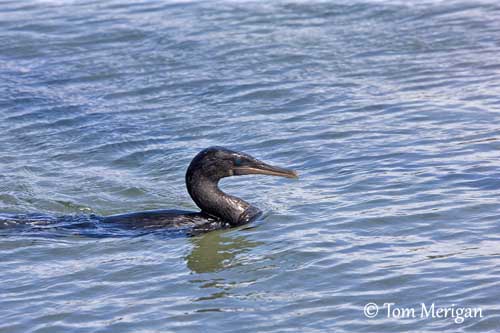
P. harrisi
Cormorants and shags are silent outside the breeding colonies where vocal displays can be heard, often related to breeding behaviour. At roosts, disputes on perches often involve vocalizations too.
The males produce various sounds such as croaking, groaning, barking, ticking and gargling calls. They are usually more vocal than the females which utter softer hissing or puffing sounds, and are often silent. The chicks make plaintive calls when begging for food.
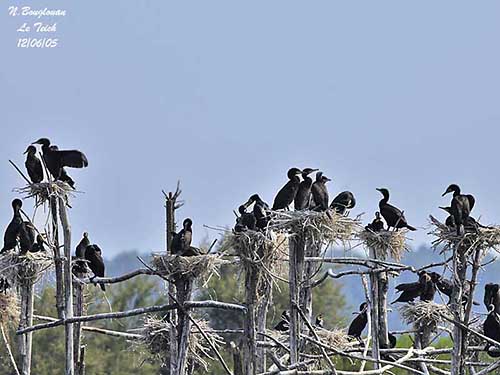
P. carbo
Calls are produced during breeding displays, or related with take-off and landing, or when the birds are threatened and alarmed. The Great Cormorant has a complex repertoire, a quite outstanding variety of loud, guttural and raucous calls. But the type of calls varies with each species.
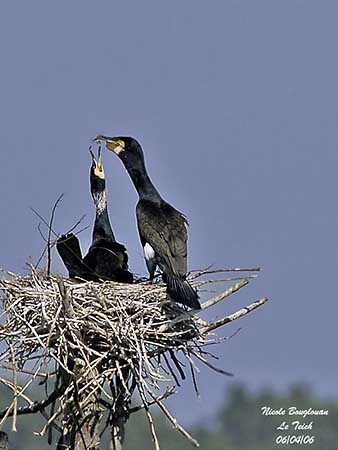
Cormorants and shags breed in colonies varying in size from a few pairs to hundreds of thousands of birds like in the Guanay Cormorant. Some colonies can have three nests per square metre.
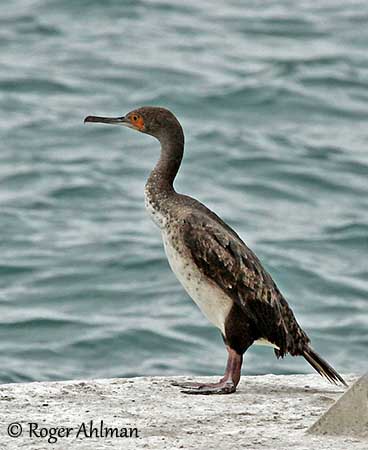
L. bougainvillii
Several species of cormorants may breed with other seabirds such as gannets, boobies, gulls, terns or penguins. The marine species establish their colonies on islands, rocks, coasts, cliff ledges, grassy slopes, cliff tops, where the nests are often placed on the ground.
The inland colonies may gather cormorants and water birds such as herons and egrets, storks, ibises, spoonbills and darters. The birds usually nest in trees surrounded by water, or in bushes or reeds. However, human buildings and moored boats are used too.
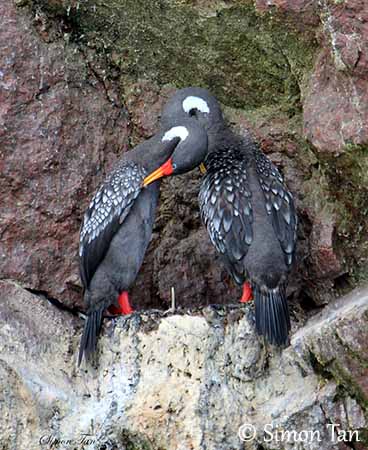
P. gaimardi
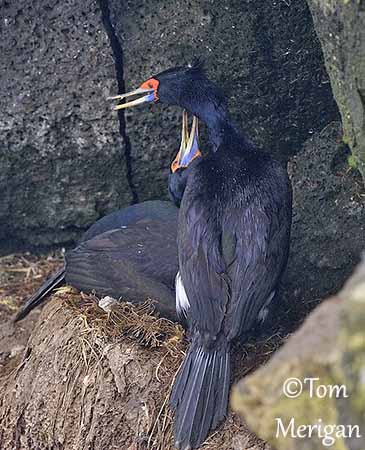
P. urile
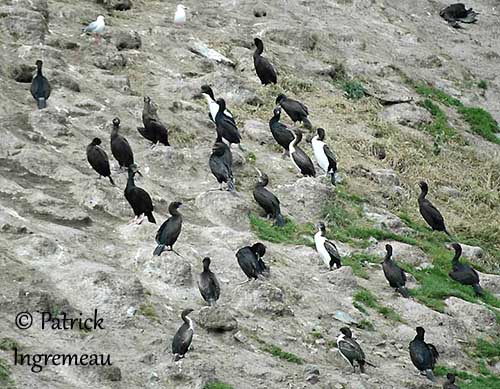
L. chalconotus
The tropical species can breed all year round with usually a peak for the laying. There is generally a single brood per year in all species, except the Flightless Cormorant which can breed twice in one year, with the peak of laying between March and September.
The nest-site is chosen by the male, sometimes the one used in the previous year. It displays from this place in order to attract a female, but she can be later accepted or rejected.
Among several displays, the “wing-waving” during which the male lifts the wing tips while the bill is pointing upwards and forwards to expose the bright colours of the throat, and the head lowered towards the back and raised again but in opposite time to the wings are the major displays. These wing movements allow the male to expose and cover alternately the white outer thigh patch, and in the species of genus Leucocarbo, to enhance the white upperwing patches.
Another display, the “gargling” involves the male throwing the head back until the nape touches the rump. During this movement, the bill is wide open and we can hear a special call.
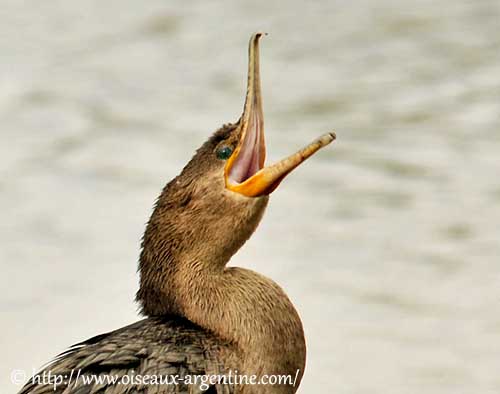
P. brasilianus
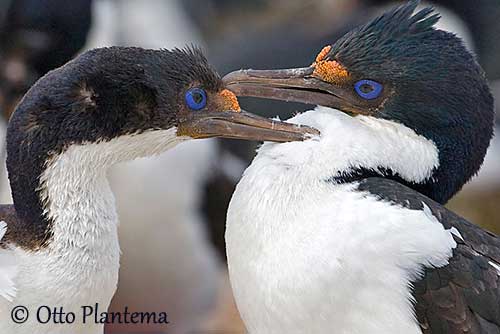
L. atriceps
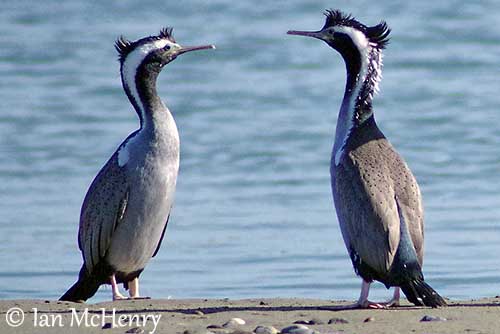
P. punctatus
The courtship of the Flightless Cormorant has an aquatic phase. Male and female circle one another as they rise up in the water while fluttering their short wings.
Once a female is accepted, “greeting displays” are performed, and usually repeated during the breeding period. Then, the female remains at the nest-site and the male collects nest-materials.
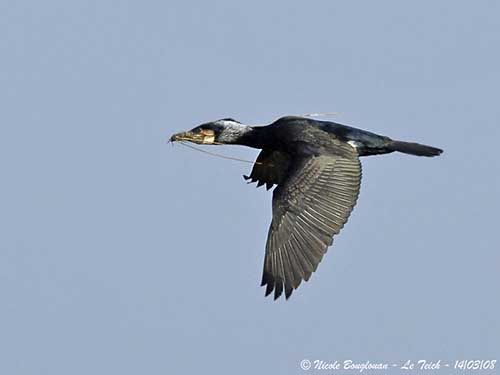
P. carbo
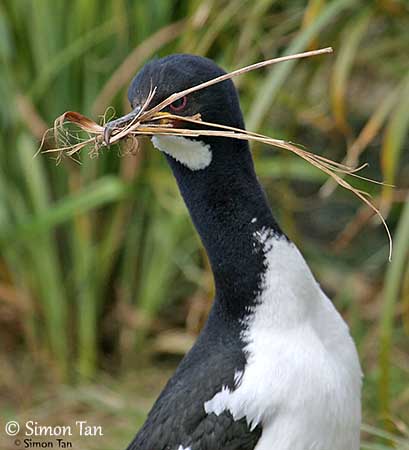
L. colensoi
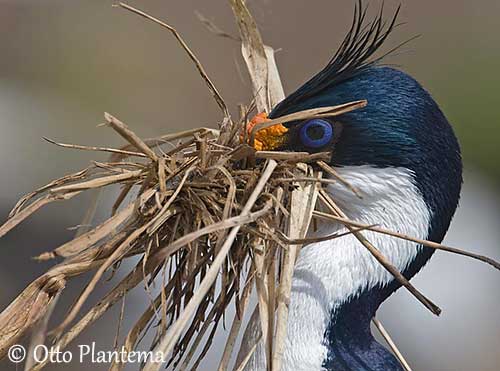
L. atriceps
The nest is built by the female and consists of plant matter, usually seaweeds cemented together with excreta. The species nesting inland make the nest with sticks and twigs. Other materials such as debris, feathers or bones can be used too, and the lining is made with green grass or small pieces of seaweed.
We can find several nest shapes, from a simple depression in sand, gravel or guano, or a nest made of plant matter placed on narrow ledges. The subantarctic shags use truncated cones of seaweeds held together with mud and excreta placed on flat ground.
Some nests are made with unusual materials. The South Georgia Shag (L. georgianus) sometimes uses penguin’s feathers, while some Flightless Cormorants add a high proportion of sea urchin and starfish to the nest.
Nest building may last from 1-5 weeks to two months in the Imperial Shag (L. atriceps). Before the laying is done, the birds guard the nest against other species in search of materials, and a small territory around the nest is defended.
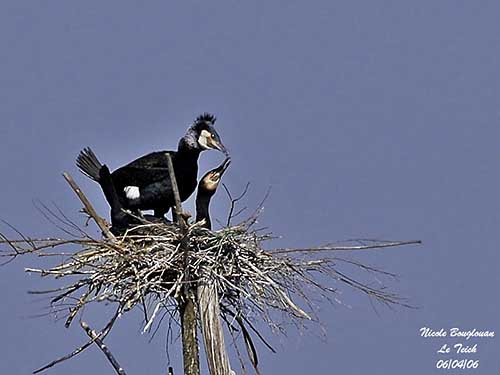
P. carbo
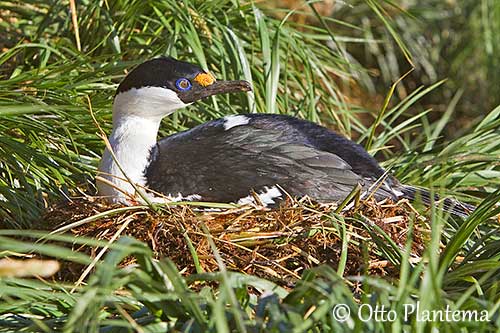
L. georgianus
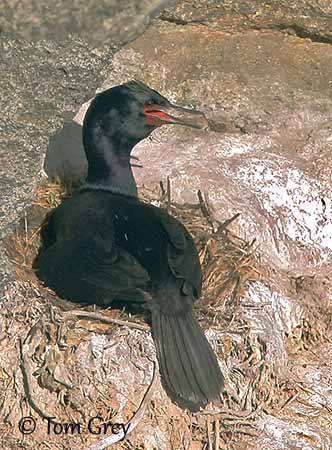
P. pelagicus
Cormorants are monogamous but the pair-bonds are not very strong and some cases of polygamy are recorded. The copulation takes place at the nest-site. The clutch size is usually of 2-4 pale blue or green eggs. A second clutch will depend on food availability. Both parents share the incubation during 23-35 days according to the species. They incubate with their webbed feet, and take turns of equal length. They add new materials at each changeover and throughout the breeding period.
L. atriceps
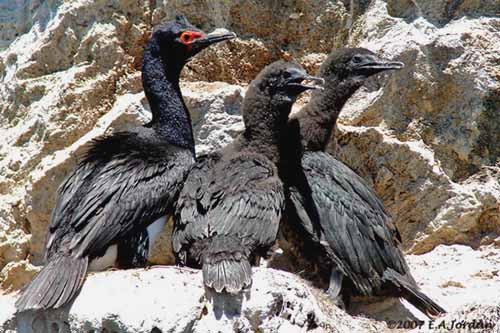
P. magellanicus
At hatching, the chicks are naked and helpless, only raising and waving their heads. But a week later, they have black, brown or white wooly down. Both parents share the nesting duties, and brood, protect and feed the chicks which are brooded continuously during the first week. Later, they are guarded by an adult until they are able to defend themselves.
In hot weather, they are shaded and the adults may bring wet plant matter to cool the nest and water for the chicks. They are fed first by regurgitated liquid food, and later, they insert their head into the adult’s throat to get solid food.
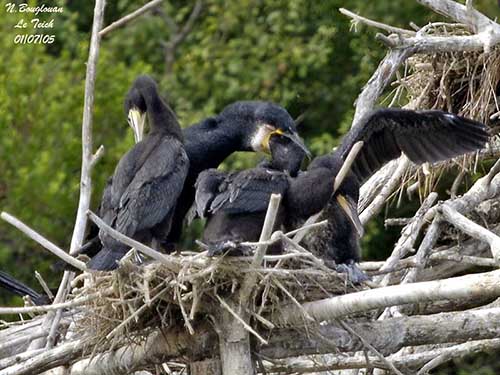
P. carbo
They grow rapidly and most species fledge about 50 days after hatching, some of them at 80 days old. Successful broods produce 1-3 fledglings. They often leave the nest-site and gather at crèches. They can return to the nest to be fed, or they are fed in their crèches like in the Red-legged Cormorant (P. gaimardi) which nests on narrow rocky ledges. The chicks are
usually fed during two or three months and more after leaving the nest.
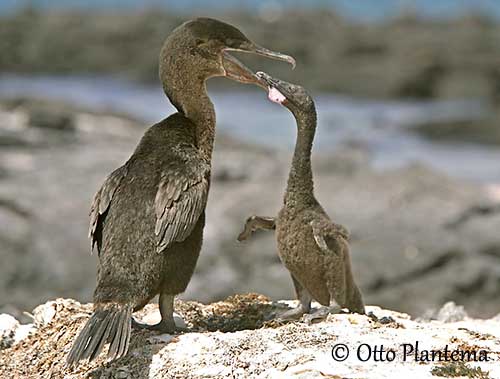
P. harrisi
Most species are mainly sedentary but usually, the juveniles perform post breeding dispersion. The young Bank Cormorants may travel several hundreds of kilometres away from their native colonies. The island species are totally sedentary and remain all year round in the surrounding waters. Only local movements can be observed, often related to research of stretches of ice-free water. The northernmost populations from Siberia and Alaska move southwards in winter.
But the migratory tendency is variable among the different subspecies and populations, and these movements may depend on food availability, weather conditions, droughts and periodic flooding, but also on natural events such as El Niño.
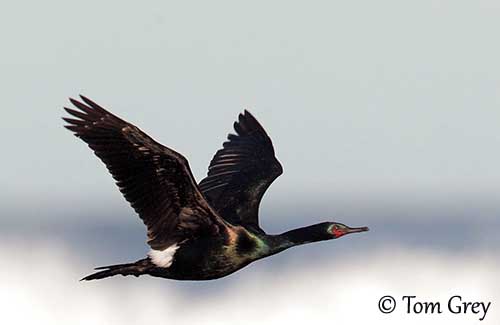
P. pelagicus
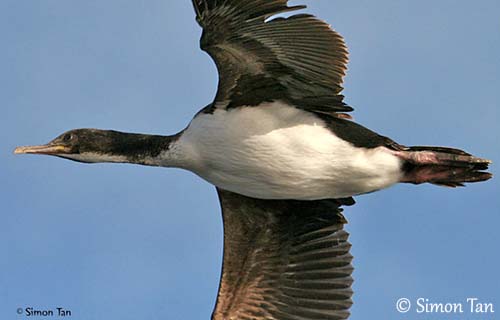
L. colensoi
Formerly, cormorants have been used in the Old World and in Britain for fishing, and this very ancient custom still goes on today in China whereas in Japan, it has now become a tourist attraction.
The huge colonies of some cormorant species lead to the accumulation of deep deposits of guano, formerly used by the Incas before the arrival of the Europeans in America. The “guano trade” generated great quantities of money and the greatest producer is the Guanay Cormorant also named “the most valuable bird in the world” or “the billion dollar bird”. However, other bird species such as gannets, boobies and pelicans were also important guano producers.
But the continuous extraction of guano caused breeding failures among seabirds due to the disturbance. In addition, the use of eggs, chicks and adults to feed the workers, and the destruction of the habitat involved a great decrease in the populations, and consequently in their annual guano production.
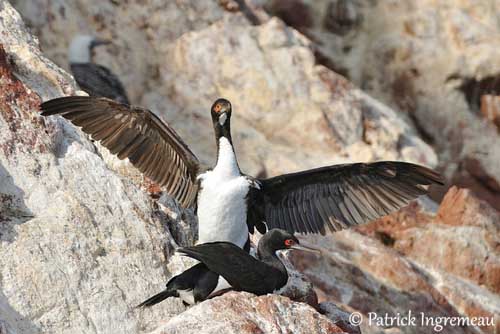
L. bougainvillii
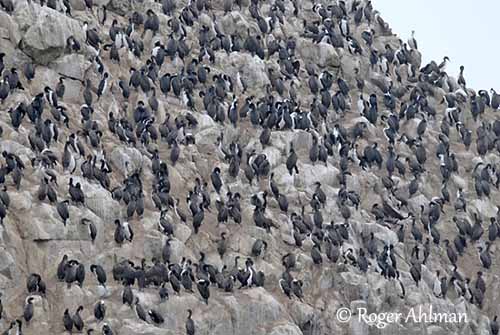
Following these problems, the breeding colonies in Peru and other guano areas were protected and maintained, with guards stationed to prevent people entering these areas. Other conservation measures such as shooting of predators, walls to isolate the birds from terrestrial intruders and predators, and increase of breeding habitat were put in place. The extraction was continuing but at a limited level and during short periods every one or two years outside the breeding season.
Egg-collecting and killing of both young and adults for human consumption still persist today in the least developed regions. Many other uses of cormorants including medicinal values have affected the populations.
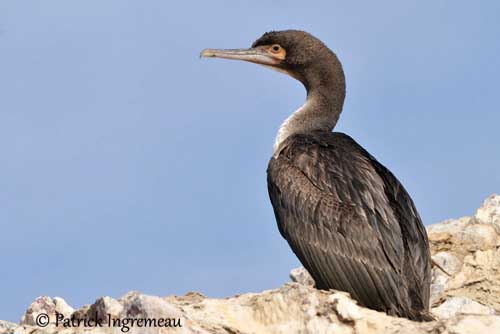
Several living species have very restricted range and small populations, making them vulnerable to various threats. The populations of the subantarctic islands are small, with only a few hundred birds on each island.
The continental populations have suffered considerable declines due to habitat destruction (drainage of wetlands), direct human persecution such as egg destruction and trapping, based on the simple fact that these birds had serious effects on fishing concerns. However, with the decrease of human persecution, the numbers of cormorants have increased.
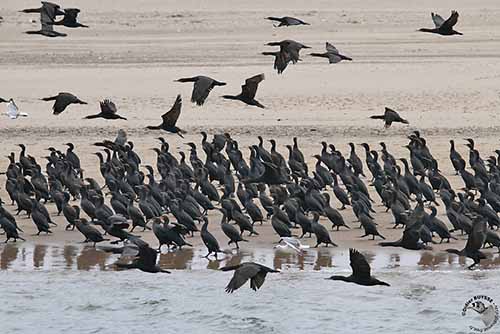
Cape Cormorant
P. capensis
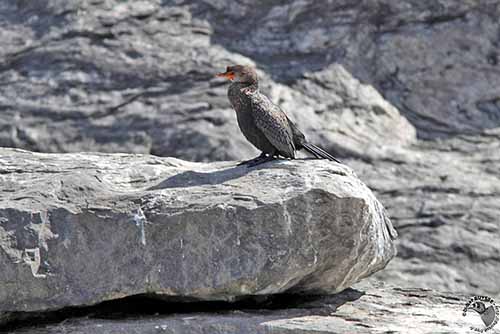
Crowned Cormorant
M. coronatus
Cormorants are also threatened by human disturbance at breeding colonies due to tourism development, predation by domestic or feral animals, trapping in fishing nets, marine pollution, El Niño phenomenon roughly every five years, and overfishing affecting especially the anchoveta stock, involving an enormous reduction of the bird populations.
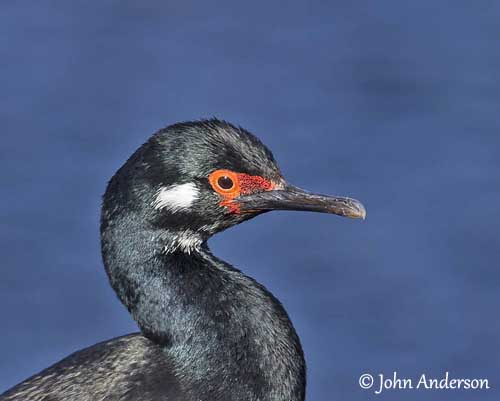
P. magellanicus
Due to their black appearance and their presence on sea coasts, the cormorants were called “corvus marinus” in Latin (sea crow) and this term is still used in several languages to describe these birds. Cormorants are mentioned in legends, especially in Tierra del Fuego. However, according to the countries, cormorants can be a warning of bad luck to come if they perch atop a church, but in other parts of the world, they are considered to be good luck when they gather in a village. In several cultures, it is considered a symbol of nobility and indulgence.
Cormorants and shags are amazing birds.
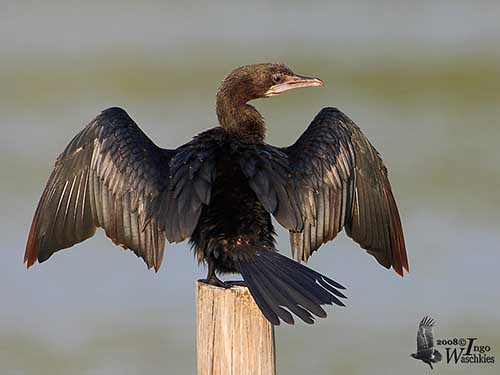
Little Cormorant
M. niger
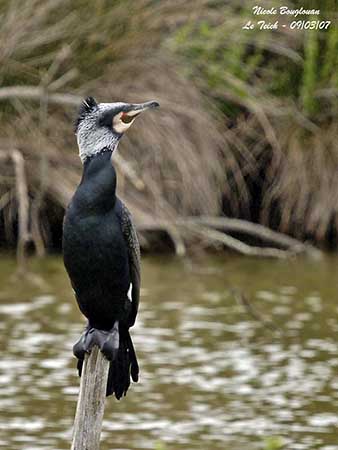
P. carbo
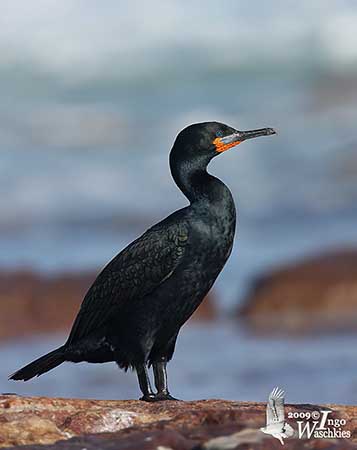
Cape Cormorant
P. capensis
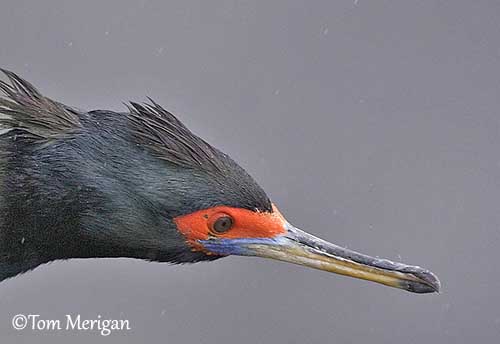
P. urile